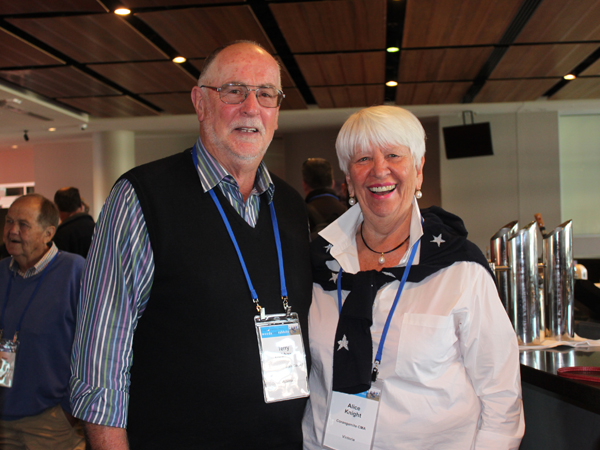Better when we’re together
By Heidi Kleinert
For over a century, communities across Australia have been battling the impact of introduced weeds and pests. There have been research trials, incentive schemes, biological control programs, new agencies and community groups. And yet here we are in 2017 still facing a formidable challenge in managing established invasive species such as blackberry, gorse, serrated tussock and rabbits.
In dealing with this challenge, there is growing acknowledgement of the complexity of weed and rabbit management. It occurs on a vast spatial scale, and is influenced by countless ecological and economic factors.

Participants at the invasive species workshop. Terry Hubbard (Victorian Landcare Council) and Alice Knight (Corangamite CMA).
Perhaps one of the biggest parts of this complexity, though, is the people issue. It’s people at the coalface that undertake the control activities, it’s people in community groups coordinating projects, and it’s people within industry and government developing the necessary policies and support programs.
If our approach to weed and rabbit management is to become more effective and sustainable, we need to build the capacity of those people and help them to work across their differences.
The Victorian Government has recognised that managing weeds and rabbits requires thinking outside the box. Funding received from the Australian Government’s Agriculture Competitiveness White Paper has enabled Agriculture Victoria to introduce a ‘systems approach’ to understand and respond to the problem as a community.
The systems approach involves working in collaboration with four Community Pest Management Groups (CPMGs) to map the management systems: the Victorian Blackberry Taskforce, Victorian Gorse Taskforce, Victorian Serrated Tussock Working Party and Victorian Rabbit Action Network. But this is not about mapping the geographical locations of pests or weeds. Rather, it is about understanding the relationships between all the groups and institutions that interact in managing blackberry, gorse, serrated tussock and rabbits, in order to define the gaps, problems and opportunities.
It is a novel way of looking at the issue, but it builds on the work and networks already established by CPMGs. In early 2017, the project completed a series of social systems maps by undertaking more than 110 interviews and several focus group sessions. The Victorian community were also invited to have their say through a blog weedsandrabbits.com.
The research identified the key stakeholders, and who else needs to be around the table in co-developing projects. It pin-pointed the trigger-points of influence, what has and hasn’t worked in historical programs, where and how funding and information flow, and how we can improve those flows.
The end goal of the project is to enhance participation in weed and rabbit management, and improve community opportunities to tackle these invasive species.
To share all the information from the study and bring the whole system together, Agriculture Victoria and the CPMGs hosted an invasive species workshop. Over 130 people who work in weed and rabbit management across the state attended the event.
The intent of the workshop was to enable participants to understand and share the different perspectives and experiences of their counterparts, and to identify where in each system action could be undertaken to support better outcomes for invasive species management. Workshop participants were also invited to submit project ideas to Agriculture Victoria and the CPMGs for investment, with the aim of further empowering communities to lead and deliver effective weed and rabbit management.
Agriculture Victoria Program Manager Michael Reid can see that this new approach is starting to build momentum. Its strength, he says, is in its recognition that those working at the coalface bring invaluable experience to the table.
“If we are to make further headway in managing these problems, we need to work in partnership. Partnerships are more than the provision of funds, they are about acknowledging local knowledge and experience as co-creators of projects,” Michael says.
Projects that were submitted at the workshop and by the CPMGs will see an investment close to $900,000 over 2017-2019. These projects will be community-led and delivered by the four CMPGs.
Heidi Kleinert is a Community Engagement Officer in established invasive species at Agriculture Victoria. Lauren Hull, Michael Reid, Paul Dennis and Andrew Woolnough from Agriculture Victoria contributed to this article.



